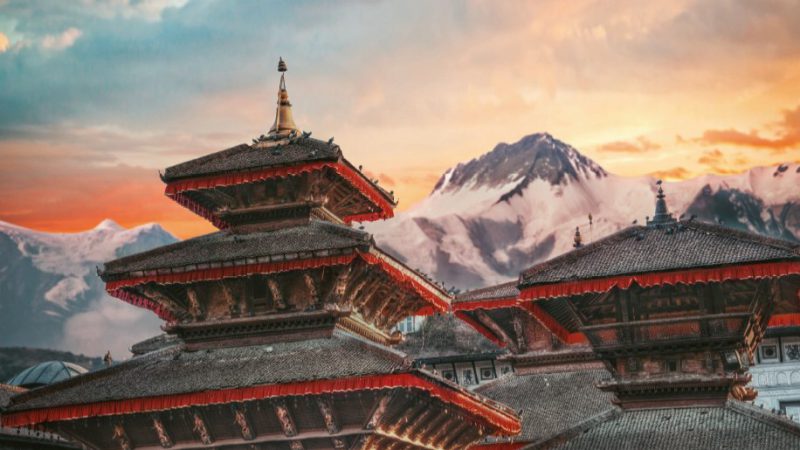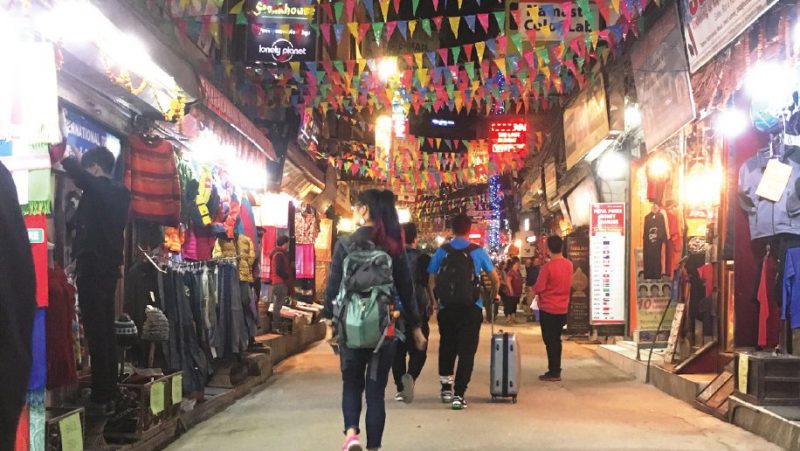Into the Mountains
With its endearing culture, fascinating architecture and scenic nature, Kathmandu is a constant surprise
October 26, 2019


An obvious place to start your visit to Kathmandu, Thamel is the city’s central point. A number of tiny lanes and alleys make up this area that’s best explored in a rickshaw. From pashmina shawls, antique jewelry, Buddhist souvenirs, Nepalese curios and artifacts, there’s little you can’t find in Thamel’s vibrant shops. Hone your haggling skills here since you’ll find tourists are quoted exorbitant prices.

If you’re interested in Nepalese cuisine, visit one of the traditional momo houses. Momo, a type of South Asian dumpling native to Nepal, are dim sum-like pockets filled with meat – mostly pork – dipped in a red chili sauce. The smell of fresh dumplings, the sounds of chants and soft Nepalese music and Buddhist flags swaying against the sky – that is what an evening in Thamel is made of.
While the youthful crowd epitomizes the face of contemporary Nepal, this area is also one of the oldest parts of the city. A short walk will bring you to Durbar Square, a UNESCO World Heritage Site, with spectacular Newa architecture typical to the region.
Durbar Square is prominent in Nepal’s history with its palaces of the Malla and Shah kings who once ruled over the city. Despite the devastating earthquake that hit Nepal in April 2015, a number of ancient temples still stand tall around the square, with their pagoda type roofs and elaborately carved windows.
Durbar Square also houses the residence of Kumari – the country’s “living goddess” based on the tradition of worshipping a prepubescent girl who symbolizes sacred female energy. As soon as she hits puberty, she is replaced by another prepubescent girl.
Called Kumari Ghar (residence), her home overlooks the south side of Durbar Square. Tourists and patrons can enter the courtyard of the house where the “living goddess” occasionally makes an appearance on one of the first floor windows. It is believed that her facial expressions depict the answers to the questions asked by her devotees. If she has no extreme reaction during her appearance, her devotees usually leave relieved as it implies good fortune.
Those interested in the Newa style of architecture should also visit Patan Durbar Square, located in the city of Lalitpur only 4 miles from Kathmandu. Another UNESCO World Heritage Site, the square is known for the ancient royal palace where the Malla kings of Lalitpur lived.
A Day at Dhulikhel Village
Drive an hour southwards from Kathmandu to the mountain village of Dhulikhel. Located along the eastern rim of the Kathmandu Valley and to the south of the Himalaya, this village offers stunning views of the snow-capped mountain range. The surrounding hills are covered with vibrant green offer a sharp contrast to the stark white snow.
Here Newari houses from medieval times houses are excellent examples of old Nepalese architecture. Walk around its narrow streets where finely carved windows and doors transport you into a past era.
When you’ve sufficiently built up an appetite and are in the mood for some homegrown luxury, step into Dwarika’s Resort at Dhulikhel. Founded on the premise of Ayurveda, yoga and holistic living, this all-suite hotel is an opulent escape compared to the simplicity of the village.
The hotel features unique treatment rooms that feature various facets of Ayurveda and offers therapies based on Vedic and Buddhist philosophies. Similarly, there is also a Chakra Sound Therapy Chamber that houses rooms dedicated to the seven chakras of the human body.
If spending the night here seems out of the budget (prices start upwards of $360 a night), you could dine at one of its restaurants. Nature’s Flavours serves local cuisine prepared with organic ingredients grown at the hotel’s farms.
Boudhanath and Pashupatinath
On the northeastern side of Kathmandu lies Boudhanath — one of the largest Buddhist stupas (dome-shaped buildings erected as Buddhist shrines). The large white dome is the main point of this complex with a series of prayer flags that are tied from its center to the dome’s circumference. The dome’s 13 levels symbolize the stages a human must pass through to achieve nirvana.
Another fascinating religious labyrinth in Kathmandu is the Pashupatinath Temple. Dedicated to Lord Shiva, the god of destruction in Hindu mythology, or Pashupati in Nepalese culture, this temple complex is situated on the banks of the Bagmati River. A UNESCO World Heritage Site, the courtyard is built in the Nepalese pagoda style of architecture.
Gold-plated copper is used to decorate the two-level roofs. A giant bronze bull (Nandi) stands at the front of the western gate of the main temple courtyard. Photography is strictly prohibited here and long queues are considered normal for a glimpse of the main lingam (symbolic of divine energy) that sits inside.
Fly Alongside Mount Everest
Have you ever boarded a flight which had no final destination? Nepal’s homegrown airline – Buddha Air – has a unique experience designed for travelers who aspire to be up close to Mount Everest without actually climbing it. The airline flies its 19-seater Beechcraft 1900 every day at 6 AM from Kathmandu’s Tribhuvan International Airport.
As a passenger of flight U4102, your boarding pass reads “mountains” as the destination. It’s a typical flight except in this case, you land back at the same airport you took off from. However, the journey is an exceptional one, bringing you within 20 miles of the tallest mountain in the world – Mount Everest.
Each passenger is assigned a window seat, and on takeoff the aircraft ascends high up to the Himalayan range as you fly over glaciers, lakes and snow peaks. And then appears Mount Everest, the earth’s highest mountain above sea level, located in the Mahalangur Himal sub-range of the Himalayas.
At this point, the crew opens the door into the cockpit allowing passengers to admire the peak from the pilot’s window. About 40 minutes or so in, the plane turns around and flies back to Tribhuvan International Airport, marking the end of this unconventional joy ride.
Where to Stay
Fairfield by Marriott Kathmandu
Set in the commercial hub of Thamel in Kathmandu, Fairfield by Marriott is a popular choice among business as well as leisure travelers. Marriott International’s first property in Nepal, the 115-key hotel offers laundry, a fitness center and free WiFi. Its only F&B offering is the Kava restaurant and bar. marriott.com
Radisson Hotel Kathmandu
Radisson Hotel Kathmandu is in close proximity to commercial and entertainment spots such as Thamel and Pashupatinath Temple. Amenities at this 260-room hotel include several F&B outlets, a health club, a spa and salon, and a business class lounge. radisson.com
Hotel Yak and Yeti
Yak and Yeti is a 270-room luxury property that offers two restaurant options, plus a bar. Guests can also indulge in the wellness services at Nirvana Spa, and there’s a fitness center, a swimming pool, and a tennis court. Additionally, the hotel has a range of meeting and event venues. yakandyeti.com




